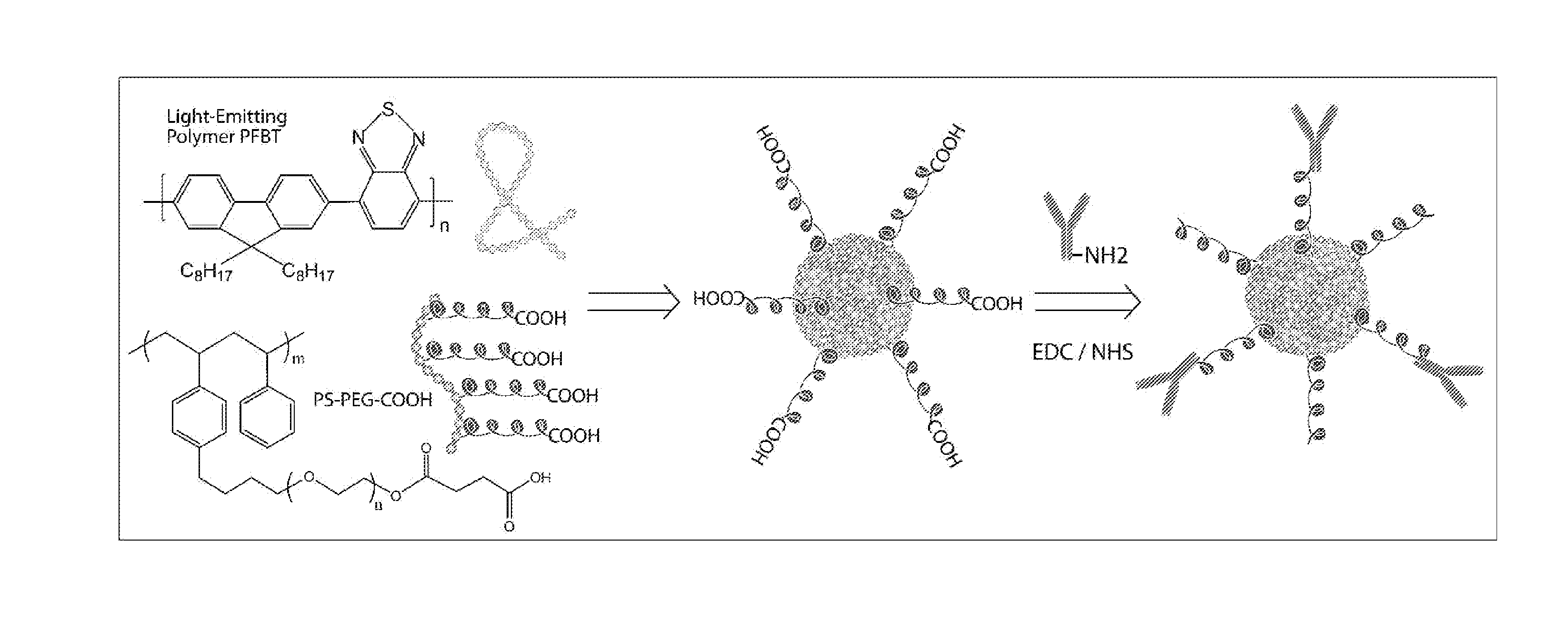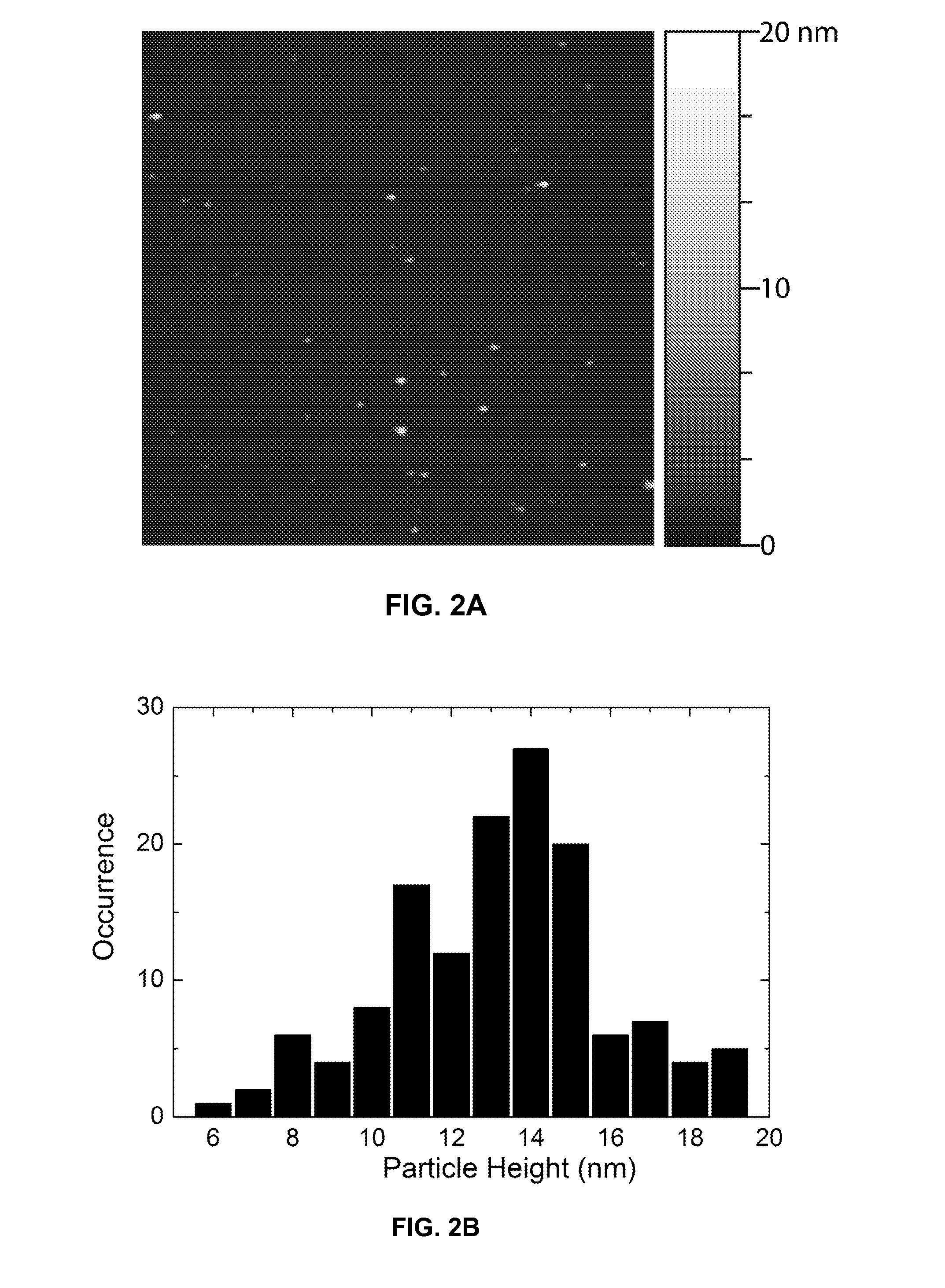Functionalized chromophoric polymer dots and bioconjugates thereof
a technology bioconjugates, which is applied in the direction of luminescent compositions, instruments, chemistry apparatuses and processes, etc., can solve the problems of low absorption, poor photostability, and insufficient brightness and photostability of chromophoric polymer dots, so as to reduce the non-specific adsorption of biological molecules
- Summary
- Abstract
- Description
- Claims
- Application Information
AI Technical Summary
Benefits of technology
Problems solved by technology
Method used
Image
Examples
example 1
Method for Preparing Functionalized Chromophoric Polymer Dots
[0239]The present example provides a method for obtaining a quantity of functionalized chromophoric polymer dots for subsequent characterization and biomolecular conjugation. FIG. 1 shows a schematic diagram for preparing the functionalized chromophoric polymer dots and their biomolecular conjugates.
[0240]Functionalized chromophoric polymer dots in aqueous solution were prepared as follows. First, a chromophoric polymer, for example PFBT, was dissolved in tetrahydrofuran (THF) by stirring under inert atmosphere to make a stock solution with a concentration of 1 mg / mL. Certain amount of functionalization agent, for example PS-PEG-COOH in THF solution, was mixed with a diluted solution of PFBT to produce a solution mixture with a PFBT concentration of 40 μg / mL and a PS-PEG-COOH concentration of 4 μg / mL. The mixture was stirred to form homogeneous solutions. A 5 mL quantity of the solution mixture was added quickly to 10 mL o...
example 2
AFM Characterization of Functionalized Chromophoric Polymer Dots
[0241]The functionalized chromophoric polymer dots prepared according to the method provided in Example 1 were assessed by AFM for their size, morphology and monodispersity. For the AFM measurements, one drop of the nanoparticle dispersion was placed on freshly cleaved mica substrate. After evaporation of the water, the surface was scanned with a Digital Instruments multimode AFM in tapping mode. FIG. 2A shows a representative AFM image of the functionalized chromophoric polymer dots. A particle height histogram taken from the AFM image indicates that most particles possess diameters in the range of 10-20 nm (FIG. 2B). The lateral dimensions are also in the range of 10-20 nm after the tip width is taken into account. The morphology and size are consistent with those of the polymer dots prepared without functionalization polymer, indicating the presence of a small amount of amphiphilic polymer has no apparent effect on p...
example 3
Optical Characterization of Functionalized Chromophoric Polymer Dots
[0242]The functionalized chromophoric polymer dots prepared according to the method provided in Example 1 were assessed for their fluorescence properties. UV-Vis absorption spectra were recorded with a DU 720 spectrophotometer using 1 cm quartz cuvettes. Fluorescence spectra were collected with a Fluorolog-3 fluorometer using a 1 cm quartz cuvette. The functionalized chromophoric polymer dots exhibit similar absorption and emission spectra to those of bare chromophoric polymer dots (FIG. 3), indicating the surface functionalization does not effect the optical properties of the polymer dots. Depending on the chromophoric polymer species, the chromophoric polymer dots exhibit absorption bands ranging from 350 nm to 550 nm, a wavelength range that is convenient for fluorescence microscopy and laser excitation. FIG. 3 shows the absorption and emission spectra of functionalized chromophoric polymer PFBT. Analysis of the ...
PUM
| Property | Measurement | Unit |
|---|---|---|
| Fraction | aaaaa | aaaaa |
| Fraction | aaaaa | aaaaa |
| Fraction | aaaaa | aaaaa |
Abstract
Description
Claims
Application Information
 Login to View More
Login to View More - R&D
- Intellectual Property
- Life Sciences
- Materials
- Tech Scout
- Unparalleled Data Quality
- Higher Quality Content
- 60% Fewer Hallucinations
Browse by: Latest US Patents, China's latest patents, Technical Efficacy Thesaurus, Application Domain, Technology Topic, Popular Technical Reports.
© 2025 PatSnap. All rights reserved.Legal|Privacy policy|Modern Slavery Act Transparency Statement|Sitemap|About US| Contact US: help@patsnap.com



